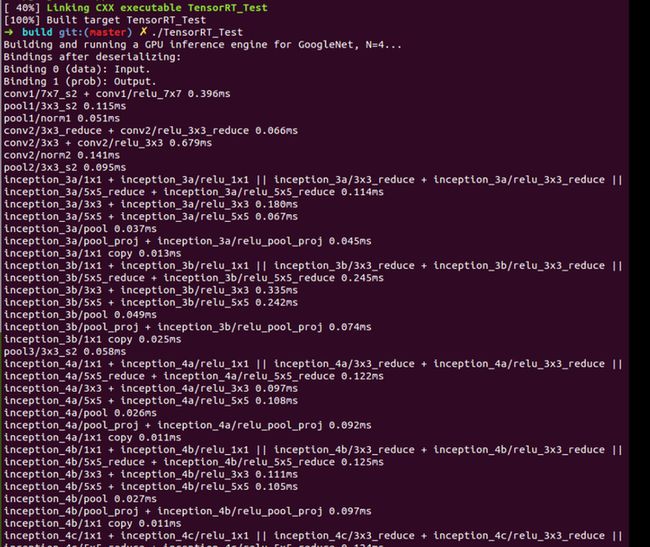TensorRT Samples: GoogleNet
关于TensorRT的介绍可以参考: http://blog.csdn.net/fengbingchun/article/details/78469551
GitHub: https://github.com/fengbingchun/CUDA_Test
以下是参考TensorRT 2.1.2中的sampleGoogleNet.cpp文件改写的测试代码,文件(googlenet.cpp)内容如下:
#include
#include
#include
#include
#include
#include
#include
#include
#include "common.hpp"
// reference: TensorRT-2.1.2/samples/sampleMNIST/sampleGoogleNet.cpp
namespace {
// batch size, timing iterations, input blob name, output blob name, deploy file, model file
typedef std::tuple DATA_INFO;
struct Profiler : public nvinfer1::IProfiler {
typedef std::pair Record;
std::vector mProfile;
int timing_iterations {1};
void setTimeIterations(int iteration)
{
timing_iterations = iteration;
}
virtual void reportLayerTime(const char* layerName, float ms)
{
auto record = std::find_if(mProfile.begin(), mProfile.end(), [&](const Record& r){ return r.first == layerName; });
if (record == mProfile.end())
mProfile.push_back(std::make_pair(layerName, ms));
else
record->second += ms;
}
void printLayerTimes()
{
float totalTime = 0;
for (size_t i = 0; i < mProfile.size(); ++i) {
fprintf(stdout, "%s %4.3fms\n", mProfile[i].first.c_str(), mProfile[i].second / timing_iterations);
totalTime += mProfile[i].second;
}
fprintf(stdout, "Time over all layers: %4.3f\n", totalTime / timing_iterations);
}
};
int caffeToGIEModel(const std::string& deployFile, // name for caffe prototxt
const std::string& modelFile, // name for model
const std::vector& outputs, // network outputs
unsigned int maxBatchSize, // batch size - NB must be at least as large as the batch we want to run with)
nvinfer1::IHostMemory *&gieModelStream, Logger logger)
{
// create API root class - must span the lifetime of the engine usage
nvinfer1::IBuilder* builder = nvinfer1::createInferBuilder(logger);
nvinfer1::INetworkDefinition* network = builder->createNetwork();
// parse the caffe model to populate the network, then set the outputs
nvcaffeparser1::ICaffeParser* parser = nvcaffeparser1::createCaffeParser();
bool useFp16 = builder->platformHasFastFp16();
nvinfer1::DataType modelDataType = useFp16 ? nvinfer1::DataType::kHALF : nvinfer1::DataType::kFLOAT; // create a 16-bit model if it's natively supported
const nvcaffeparser1::IBlobNameToTensor* blobNameToTensor = parser->parse(deployFile.c_str(), modelFile.c_str(), *network, modelDataType);
CHECK(blobNameToTensor != nullptr);
// the caffe file has no notion of outputs, so we need to manually say which tensors the engine should generate
for (auto& s : outputs)
network->markOutput(*blobNameToTensor->find(s.c_str()));
// Build the engine
builder->setMaxBatchSize(maxBatchSize);
builder->setMaxWorkspaceSize(16 << 20);
// set up the network for paired-fp16 format if available
if(useFp16)
builder->setHalf2Mode(true);
nvinfer1::ICudaEngine* engine = builder->buildCudaEngine(*network);
CHECK(engine != nullptr);
// we don't need the network any more, and we can destroy the parser
network->destroy();
parser->destroy();
// serialize the engine, then close everything down
gieModelStream = engine->serialize();
engine->destroy();
builder->destroy();
nvcaffeparser1::shutdownProtobufLibrary();
return 0;
}
int timeInference(nvinfer1::ICudaEngine* engine, const DATA_INFO& info, Profiler* profiler)
{
// input and output buffer pointers that we pass to the engine - the engine requires exactly ICudaEngine::getNbBindings(),
// of these, but in this case we know that there is exactly one input and one output.
CHECK(engine->getNbBindings() == 2);
void* buffers[2];
// In order to bind the buffers, we need to know the names of the input and output tensors.
// note that indices are guaranteed to be less than ICudaEngine::getNbBindings()
int inputIndex = engine->getBindingIndex(std::get<2>(info).c_str()), outputIndex = engine->getBindingIndex(std::get<3>(info).c_str());
// allocate GPU buffers
nvinfer1::DimsCHW inputDims = static_cast(engine->getBindingDimensions(inputIndex)), outputDims = static_cast(engine->getBindingDimensions(outputIndex));
size_t inputSize = std::get<0>(info) * inputDims.c() * inputDims.h() * inputDims.w() * sizeof(float);
size_t outputSize = std::get<0>(info) * outputDims.c() * outputDims.h() * outputDims.w() * sizeof(float);
cudaMalloc(&buffers[inputIndex], inputSize);
cudaMalloc(&buffers[outputIndex], outputSize);
nvinfer1::IExecutionContext* context = engine->createExecutionContext();
context->setProfiler(profiler);
// zero the input buffer
cudaMemset(buffers[inputIndex], 0, inputSize);
for (int i = 0; i < std::get<1>(info); ++i)
context->execute(std::get<0>(info), buffers);
// release the context and buffers
context->destroy();
cudaFree(buffers[inputIndex]);
cudaFree(buffers[outputIndex]);
return 0;
}
} // namespace
int test_googlenet()
{
fprintf(stdout, "Building and running a GPU inference engine for GoogleNet, N=4...\n");
// stuff we know about the network and the caffe input/output blobs
DATA_INFO info(4, 1000, "data", "prob", "models/googlenet.prototxt", "models/googlenet.caffemodel");
Logger logger;
// parse the caffe model and the mean file
nvinfer1::IHostMemory* gieModelStream{ nullptr };
caffeToGIEModel(std::get<4>(info), std::get<5>(info), std::vector{std::get<3>(info)}, std::get<0>(info), gieModelStream, logger);
// create an engine
nvinfer1::IRuntime* infer = nvinfer1::createInferRuntime(logger);
nvinfer1::ICudaEngine* engine = infer->deserializeCudaEngine(gieModelStream->data(), gieModelStream->size(), nullptr);
fprintf(stdout, "Bindings after deserializing:\n");
for (int bi = 0; bi < engine->getNbBindings(); bi++) {
if (engine->bindingIsInput(bi) == true) {
fprintf(stdout, "Binding %d (%s): Input.\n", bi, engine->getBindingName(bi));
} else {
fprintf(stdout, "Binding %d (%s): Output.\n", bi, engine->getBindingName(bi));
}
}
Profiler profiler;
profiler.setTimeIterations(std::get<1>(info));
// run inference with null data to time network performance
timeInference(engine, info, &profiler);
engine->destroy();
infer->destroy();
profiler.printLayerTimes();
fprintf(stdout, "Done.\n");
return 0;
}
测试代码编译步骤如下(ReadMe.txt):
在Linux下通过CMake编译TensorRT_Test中的测试代码步骤:
1. 将终端定位到CUDA_Test/prj/linux_tensorrt_cmake,依次执行如下命令:
$ mkdir build
$ cd build
$ cmake ..
$ make (生成TensorRT_Test执行文件)
$ ln -s ../../../test_data/models ./ (将models目录软链接到build目录下)
$ ln -s ../../../test_data/images ./ (将images目录软链接到build目录下)
$ ./TensorRT_Test
2. 对于有需要用OpenCV参与的读取图像的操作,需要先将对应文件中的图像路径修改为Linux支持的路径格式GitHub: https://github.com/fengbingchun/CUDA_Test
